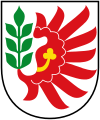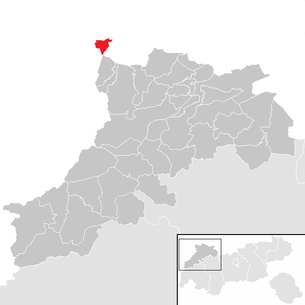Young wood
|
Young wood
|
||
|---|---|---|
| coat of arms | Austria map | |
|
|
||
| Basic data | ||
| Country: | Austria | |
| State : | Tyrol | |
| Political District : | Reutte | |
| License plate : | RE | |
| Surface: | 7.05 km² | |
| Coordinates : | 47 ° 34 ' N , 10 ° 27' E | |
| Height : | 1054 m above sea level A. | |
| Residents : | 308 (January 1, 2020) | |
| Postcodes : | 6691 (Austria) 87491 (Germany) |
|
| Area code : | 05676 | |
| Community code : | 7 08 18 | |
| NUTS region | AT331 | |
| Address of the municipal administration: |
Jungholz 55 6691 Jungholz |
|
| Website: | ||
| politics | ||
| Mayoress : | Karina Konrad | |
|
Municipal Council : (2016) (11 members) |
||
| Location of Jungholz in the Reutte district | ||
| Source: Municipal data from Statistics Austria | ||
Jungholz is a Tyrolean municipality in the Tannheimer Tal region in the Reutte district with an area of 7 km² and 308 inhabitants (as of January 1, 2020), the center of which is at an altitude of 1054 m above sea level. A. lies. The community is located in the judicial district of Reutte . Since it is almost completely surrounded by German territory, the locals also refer to it as “a piece of Tyrol in the Allgäu ”.
geography
The municipality is surrounded all around by Bavaria and can only be reached via German territory, via the German cross-alpine road from Oberjoch via Wertach, from the rest of Tyrol in Austria. It is only connected to the rest of Tyrol at one point near the 1636 m high summit of the Sorgschrofen . This makes it a functional exclave .
The following localities are in the municipality: The villages of Gießenschwand, Langenschwand, Obere Höfen and Untere Höfen, the hamlet of Habsbichl and the Stubentalalpe and Älpele Alps . Upper courtyards used to be called only courtyards , while lower courtyards were called Höfle .
Neighboring communities
The neighboring communities of Jungholz with a linear border, i.e. more than point-like contact, are all on German territory. These are Bad Hindelang (southwest), Wertach (west and north), Nesselwang (northeast) and Pfronten (east). At the point where Jungholz touches the rest of Tyrol on the summit of the Sorgschrofen , there is a neighborhood to the south of the community of Schattwald in the Tannheimer Tal . The two federal German municipalities whose area touches here are Bad Hindelang ( district Unterjoch) to the west and Pfronten (district Steinachpfronten) to the east of the border point.
history
Jungholz was first mentioned in a sales contract between a resident of Wertach (Hermann Häselin) and one from the Tannheimer Tal (Heinz Lochpühler), which was concluded on June 24, 1342. This brought the area from Bavaria to Tyrol and remained there despite several border disputes. The final definition of the borders between the Kingdom of Bavaria and the Empire of Austria was made by the Border Treaty of 1844 and another treaty of 1850.
Customs area
The Austrian municipality of Jungholz was economically linked to the Kingdom of Bavaria through the customs treaty of May 3, 1868 .
Due to its geographical location, the municipality (like Kleinwalsertal ) is the customs connection area of the Federal Republic of Germany with a German (87491) and an Austrian postcode (6691). In 2006 the Austrian Post no longer wanted to accept the German postcodes for Jungholz and Kleinwalsertal, but continued to accept them after popular protests. The Austrian tariffs apply to shipments, including postage abroad for post to neighboring municipalities in Bavaria. The telephone code of the German Telekom (08365 - same as Wertach in Germany) has been switched off so that the place can only be reached via the Austrian telephone code.
The special geographical location also means that almost 50% of the residents are both German and Austrian citizens.
Belonging to the district of Sonthofen
From October 15, 1938 to September 8/9 May and September 19, 1945, Jungholz belonged to the Bavarian district of Sonthofen .
coat of arms
In the municipal coat of arms , the green branch growing out of a wing of the Tyrolean eagle symbolizes the settlement history and the affiliation of Jungholz to Tyrol.
Culture and sights
tourism
The first drag lift was built in 1948 and thus laid the foundation for the rise in winter tourism. The number of guests in the summer season also increased more and more in the following years. Jungholz has an outdoor swimming pool - the Felsenbad, mini golf - and a children's playground in the immediate vicinity of the swimming pool. The small town is an Allgäu herb village and the 1st Tyrolean alpine herb village. There is a large herb garden to marvel at directly at the church in Jungholz . Visitors can also help make herbal soaps and herbal salt. There are also a number of varied hiking tours available, an easy hike, for example, is the letters trail. Events such as the raising of the maypole , the fire of the Sacred Heart , the herb and handicraft market and the Viehscheid attract visitors every year.
Economy and Infrastructure
In Jungholz, the German mark was the official currency until the introduction of the euro ; This special feature made Jungholz a special financial center for German fixed assets for many years . Although Jungholz only has less than 300 inhabitants, there were three branches of Austrian banks in the village until 2015 . That made Jungholz the place with the greatest density of banks in Austria. Despite customs and currency union and the abolition of border controls due to the Schengen Agreement , Austrian banking secrecy still applies here , which is why money from Germany is still invested in young wood. And not always legally: In 2007, German officials seized 100,000 euros on the border with Jungholz.
In 1948 the first ski lift for the Reutte district and, at the same time, the Tannheimer Tal region was built in Jungholz . Two-season tourism is also of economic importance. The place regards itself as part of the two tourist regions Allgäu and Tannheimer Tal and focuses on family tourism .
Even after the introduction of the common currency, Jungholz still has the German VAT rates as a German customs connection area.
traffic
The road connections to the rest of Tyrol lead via Bavaria. The federal road 310 leads past Unterjoch to Oberjoch , where it joins the federal road 308 , which leads into the Tannheimer Tal .
See also
Web links
Individual evidence
- ↑ a b Author under the pseudonym "Ernst Stavro Blofeld": The boundary cross at Jungholz. In: Enclaves.org (archived on web.archive.org). Retrieved April 22, 2020 (English).
- ^ Statistics Austria: Ortverzeichnis Tirol , p. 155
- ↑ Topographic map sheet from 1958: 8428 Hindelang 1: 25,000
- ^ Agreement on the connection of the municipality of Jungholz, which belongs to the county of Tyrol, to the Bavarian customs and indirect tax system. Vienna, May 3, 1868 (ratified June 26, 1868). Wording in: Deutscher Zollverein: contracts and negotiations from the period from 1833 up to and including 1870 on the formation and execution of the German Customs and Trade Association. Volume 5, Staatsdruckerei, Berlin 1871, pp. 478-481 ( Google eBook, full view ).
- ↑ U- turn of the Austrian Post ( Memento of the original from December 31, 2011 in the Internet Archive ) Info: The archive link was inserted automatically and not yet checked. Please check the original and archive link according to the instructions and then remove this notice. , Website of the Kleinwalsertal, accessed on January 17, 2013
- ^ Wilhelm Volkert (ed.): Handbook of Bavarian offices, communities and courts 1799–1980 . CH Beck, Munich 1983, ISBN 3-406-09669-7 , p. 571 .
- ↑ a b The silence of the mountain lambs. (No longer available online.) In: Datum.at. April 1, 2008, archived from the original on January 2, 2014 ; accessed on January 1, 2014 . Info: The archive link was inserted automatically and has not yet been checked. Please check the original and archive link according to the instructions and then remove this notice.




